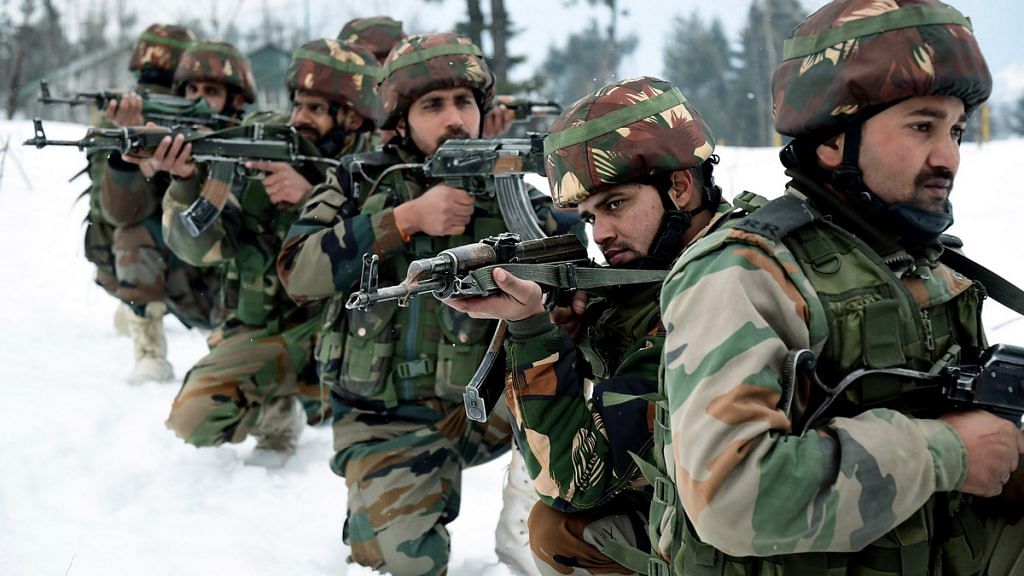New Delhi: The ongoing India-China stand-off at the Line of Actual Control (LAC) and the security situation in Kashmir and along the Line of Control (LoC) are likely to dominate the discussions at the Army Commanders’ Conference, which begins Wednesday.
There have been tensions at the LAC for the past few weeks between the Indian and Chinese military, especially in the Galwan valley, larger Hot Springs area and around Pangong Tso lake in eastern Ladakh, a part of which juts out like fingers.
On Tuesday, ThePrint reported that at least six rounds of talks were held at the local level (including the division level) in Ladakh to defuse the situation even as Chinese soldiers transgressed by about 3 km into Indian areas in at least four locations, with a troop build-up on the northern sector along the Chinese side of the LAC. This was apart from diplomatic and other efforts being undertaken to handle the issue.
According to sources in the Army, Kashmir is also likely to top the agenda during the meet given the slew of anti-terror operations security forces have undertaken in the Valley recently in the wake of attacks reportedly fuelled by new terrorist outfits. The summers also usually see an increase in infiltration bids at the LoC.
The three-day biannual event is attended by the top Army leadership to brainstorm on new security and administrative issues, and plan a roadmap.
This year’s meet, which was scheduled to be held in April, was postponed due to the coronavirus outbreak and subsequent lockdown. It is now being held in two phases, with the second phase scheduled to take place in June.
Also read: Kashmir, retirement age & artificial intelligence to be discussed at Army Commanders’ meet
Logistics and ammunition
A special focus area of the conference is likely to be logistical issues with an emphasis on ammunition management, sources said.
This could include discussions on reducing ammunition holdings and making the supply chain more efficient.
Other points, which are likely to be discussed, include integration of resources for ammunition, saving on storage space of ammunition, and the manpower required to guard ammunition depots.
In a recent interaction with a limited group of journalists, the Chief of Defence Staff General Bipin Rawat had said ammunition would be a priority when it comes to defence acquisitions across services in the wake of the Covid-19 budget cut.
He also said there had to be a push for indigenous manufacturing of ammunition given that it is largely import-dependent at the moment.
“If I start manufacturing ammunition in my own country, my stocking levels would come down. If we anticipate a tension, we can always tell the Indian manufacturers that you must have the capacity to surge. If there is a surge capacity with the industry, I can reduce my stocks,” he had said.
General Rawat had also said it is not a good idea to store large amounts of ammunition as they have a limited shelf life during which it has to be fired or destroyed.
He had said reducing storage will free up land and manpower, given that ammunition dumps use up vast swathes of land due to the mandatory safety distances and vacant spaces around it, and also because a lot of manpower has to be utilised for guarding them.
He had also said the manufacturing of ammunition should be divided between two or three companies so that even if a war lasts for 15 to 20 days, every day the Indian industry can supply one day’s ammunition, as against the risk of being denied stocks if one is dependent on imports.
Also read: Rs 30,000 pension soon for men who fought in 1965, 1971 wars but didn’t get absorbed in Army
Training of soldiers
The agenda for the conference is also likely to include various aspects of training of soldiers — an issue that emerged after the entire training schedule for the Army had to be reworked because of the Covid-19 outbreak.
The conference will likely include discussions on merging the Directorate General of Military Training (DGMT) into the Army Training Command (ARTRAC) in Shimla as both have similar functions. This is part of a greater restructuring plan of the Army headquarters.
ThePrint had earlier reported that the Indian military is actively deliberating on setting up a new joint training command to meet the training needs of all its three branches — the Army, the Navy and the Air Force.
While the defence ministry had approved three major reforms for the Army headquarters last August, the restructuring plan can’t be implemented unless the overall restructuring is approved in totality, Army sources had told ThePrint.
Streamlining of various other training-related issues and human resource aspects are also likely to be part of the discussions, Army sources said.
Sources added that other aspects likely to be showcased at the event could include the Army’s efforts extended to aid civil authorities and HADR (humanitarian, assistance and disaster relief) operations undertaken from last year, such as those which came as a response to the coronavirus pandemic. The Army’s capability development initiatives such as procurements, infrastructure development and innovations in the field of operations, training and administration and military diplomacy efforts will also likely be showcased.
Also read: Swift & sustained retaliation — what Indian Army is discussing at commanders’ meet
